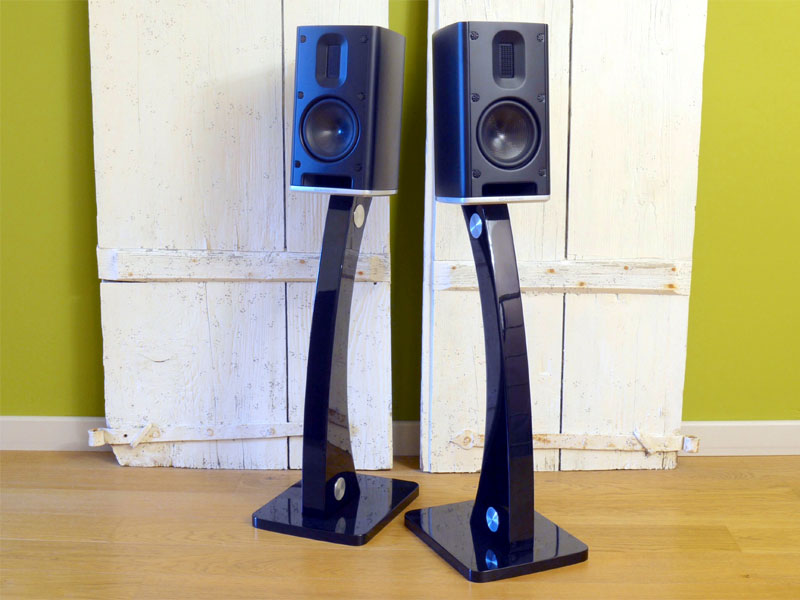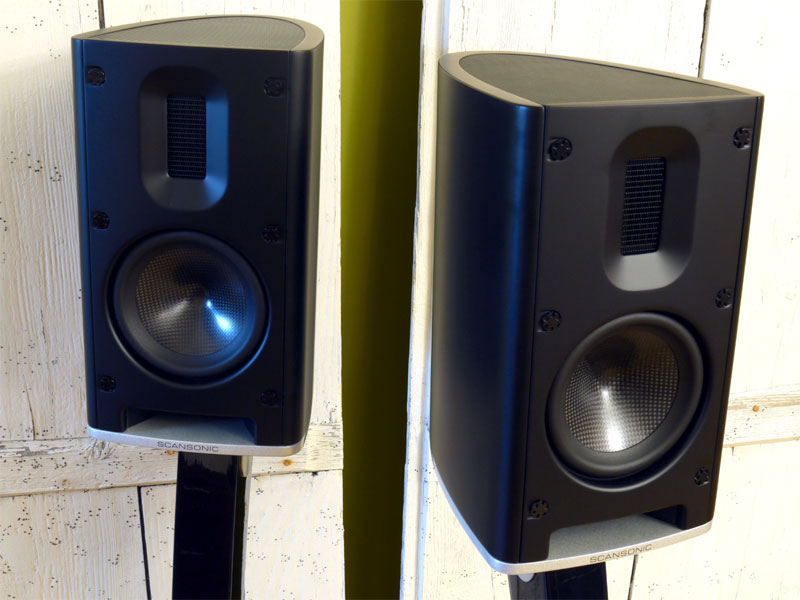What
I'd Recommend to a Friend: Scansonic MB-1
Although it has never been possible to please all of the people all of the time, Raidho arguably sailed a little too close to the wind, courting the press with considerable success but failing to match that success in sales terms. One reason for that critical success lay in the sheer clarity the speakers brought to proceedings, allowing reviewers to hear other components more easily -- something which is definitely a double-edged sword in both dealer showrooms and domestic setups. Eventually Dantax Radio, a major electronics manufacturer in Denmark, acquired Raidho, supplying much-needed financial stability and investment, and starting the move toward less extreme voicing of the products. Perhaps more importantly, though, Dantax also sought to leverage Raidho’s driver technology into a flagship line for their modestly priced Scansonic speaker brand. The result was a range of five loudspeakers and a center-channel, ranging from the diminutive MB-1 two-way stand-mount covered here, all the way up to the tall, slim floorstanding MB-6 with its seven-driver D’Appolito array. They all feature a Scansonic iteration of Raidho’s characteristic recessed planar tweeter and, just like the high-end range, they pair it with multiple visually identical cone drivers, although these use carbon-fiber diaphragms in place of the Raidho’s pale ceramic ones. The cabinets mirror the boat-back design of the Raidhos too, and if the overall dimensions are smaller, the outrigger feet and general form factor mark the Scansonic speakers as exactly what they are: a much more affordable spin-off from the high-priced, high-end line. The question, as with all such projects, is how much of the original DNA has survived the reinterpretation of the design philosophy. Is this really Raidho lite or is it only a lookee-likee, flattering to deceive? In this case, at least a part of that answer is to be found in Scansonic's pricing. More affordable the speakers might be, but they’re not exactly bargain basement. The diminutive MB-1 commands a $2250/pair asking price, while, at the other end of the range, the MB-6 weighs in at a pretty substantial $9950/pair, bringing a whole new sense to the expression "reassuringly expensive." I’ll be looking at one of the larger models in dues course, but it is the MB-1 that demands immediate attention, partly because so much of the Raidho reputation has been built on the remarkable performance of their stand-mounted designs -- the various C1 models and the uber-expensive D1 -- and partly for another reason altogether. Every reviewer needs a set of diagnostic tools, and one of the most useful is a speaker that’s small enough to be portable and capable enough to tell you just what’s happening upstream. Since its arrival, the little Scansonic has effortlessly usurped that role.
The MB-1 is smaller than its Raidho cousins, standing a mere 31cm tall, 17.5cm wide and 26.5cm deep -- or around a foot tall, 7" wide and 10" deep. Yet, each speaker weighs in at an impressive 6.1kg (13 pounds). Built on a machined and painted MDF base plate with a faux carbon-fiber top panel, the cabinet is all curved edges and walls and surprisingly solid to the touch. The classic knuckle-rap test produces a well-controlled "thunk" -- neither too lively nor too dead. The carefully profiled aluminum front baffle is held in place by six large-diameter security fixings, which, along with the absence of driver-mounting bolts, adds to the clean, high-tech appearance. The drivers are arguably what set this speaker apart. The shallow racetrack chamfer that surrounds the flat tweeter diaphragm of the in-house planar-magnetic drive unit immediately identifies the MB-1’s Raidho roots. Although the company persists in referring to it as a "ribbon," a misnomer repeated apparently ad infinitum by journalists who should know better, the Kapton substrate and the fact that it uses an etched or overlaid conductive voice coil (rather than the conductive element consisting of the entire diaphragm) rob the driver of the elusive status that goes with true ribbon construction. It also robs it of the cripplingly low impedance and requirement for a driving transformer that makes most real ribbons expensive to produce and hard to use -- which rather explains why Raidho adopted the distinctly real-world approach that they did. Not that what you label the device really matters. It either works or it doesn’t -- and in this case it definitely does. The Scansonic speakers pair the flat tweeter with 11cm/4.5" drivers with lightweight, continuous carbon-fiber cones, devoid of the traditional dust cap. In another Raidho tradition, these are driven by muscular motors using the kind of overhung voice coils more often associated with expensive monitors like those from ATC. It’s an approach that is traditionally associated with maximizing dynamic range and low-frequency control -- concerns that might seem at odds with such a miniscule driver and speaker system but speak volumes about the intent behind the design decisions, the emphasis on speed, transparency and dynamic response. In part that’s about successfully blending the output of the tweeter with the cone driver that supplies the midrange, but it’s also about producing the lively, engaging and rhythmically involving sound that has won Raidho speakers so many friends. Of course, one of the great advantages enjoyed by a speaker as small as the MB-1 is the ease of engineering a simple two-way crossover and the fact that there’s no deep bass to get in the way and trip things up. Short of getting things really wrong, you are almost guaranteed a quick, coherent sound. Instead the challenge becomes generating enough bass to satisfy without messing up that articulate, inviting midband. To that end the MB-1 employs a large, carefully flared, forward-firing slot port, a canny decision as the combination of carefully controlled flow and defined directionality means that you can push the little speakers back surprisingly close to the wall without the bottom end getting lumpy or detached. The result is bass (more accurately, midbass) that is weighty enough to surprise a listener, quick enough to add impetus to music and tight enough not to slow things down -- a nicely judged sonic sleight of hand that underpins everything the MB-1 does. This little speaker takes its Raidho heritage seriously. Play "My Favorite Things" from the Coltrane CD of the same name [Atlantic 7567-81346-2], and McCoy Tyner’s piano has that all-important infectious swing while Coltrane's sax is all little stabs and puffs of musical energy, playing with the rhythm, the spaces between notes and hesitations in the line. Likewise, the vigorously incisive playing of Amandine Beyer and Gli Incognito (from Vivaldi Concertos [Zig Zag Territoires ZZT080803]) is full of life and purpose, the sheer enthusiasm and pace disguising the tiny number of musicians involved, even while the speakers separate the instruments in space. This musical joie de vivre is something few systems or speakers achieve, and it makes the little Scansonics highly engaging and listenable. But it’s when you move from acoustic material onto what is arguable their more natural preserve of rock and pop that the MB-1s really start to shine. Their mastery of pace and flow keeps even monster anthemic tracks like Echo’s "Forgiven" (from Evergreen [London 828 905-2]) moving inexorably forwards, yet maintaining that sudden studied collapse in the finale, while tracks like "Guilty" or "Life In Her Yet" from Rag ’n’ Bone Man (Human [Sony/Best Laid Plans 88985398541]) have an impressive, gritty solidity and presence, despite the pop-standard studio mix. The MB-1s’ ability to cut through the production and fasten on the detail, creating clarity and musical direction in the murkiest of mixes, bring modern rock, pop or roots music to life. All of which makes this a remarkably versatile and musically capable little speaker -- one that successfully defies the limitations of its diminutive dimensions. The MB-1 isn’t without its flaws. Listen to the acoustic guitar on "Forgiven" and you hear the strings and attack rather than the body of the instrument -- as it ever was with the smaller Raidhos. Singers are more about mouth and diction than the chest behind the voice. The quick, clean treble is devoid of glare but does suffer the subtle wispiness and lack of substance so often associated with planar-magnetics. But, crucially, such sins of omission are far more acceptable in a speaker at this price point, less obvious in the systems in which it will find itself. Talking of which, I’ve had the chance to run the MB-1s on systems as varied as Cyrus and Mark Levinson solid-state integrated amps and tube or hybrid designs from Icon Audio, Tom Evans Audio Design, and, most ludicrously of all, €100,000 worth of Engstrom & Engstrom two-box preamp and 300B monoblocks. I’m not suggesting that all of these matches make financial or system sense, although they do show both the speaker’s versatility and its ability to grow with the driving amps. Back in the real world and in terms of the price/performance balance, results with both the Icon Audio Stereo 20 and the bigger Stereo 60 tube integrateds were spectacularly successful, and these really represent the natural partners for the little Scansonics. Pay attention to the niceties of system infrastructure by providing a proper cable solution and some decent stands and the MB-1s will seriously sing.
For years, audio consumers have suffered from a succession of small, difficult-to-drive loudspeakers that seem intent on demonstrating that you really can get deep bass out of little boxes. The results have all too often been musically clumsy, constipated and disjointed, with too many possible pitfalls present in the amp and speaker complex to deliver consistent and coherent musical results. That is not the MB-1. The little Scansonic is a thoroughly modern design, one that eschews attempts to sound bigger than it is, content instead that you shouldn’t notice it’s actually really small. It offers just enough bass weight that, combined with its speed and dynamic coherence, it can deliver impressive impact and a surprisingly satisfying impression of scale -- all while adding to rather than disturbing the clarity and coherence that make it so entertaining and musically satisfying. Rather than trying to cram a quart into a pint pot, Scansonic concentrates on the midband clarity that’s really important to the musical message and underpins it with enough foundation to keep it upright and heading in the right direction. Versatile in every sense (in terms of placement, matching and musical material) the MB-1 is an object lesson in just what a small, high-performance, high-resolution loudspeaker should be. It’s not the only credible, compact, affordable speaker in town, but if you want both audiophile and musical sensibilities and the ability to play everything from renaissance madrigals to rap music, it’s pretty much in a class on its own. |



